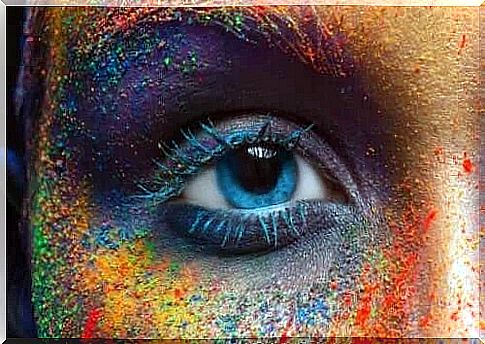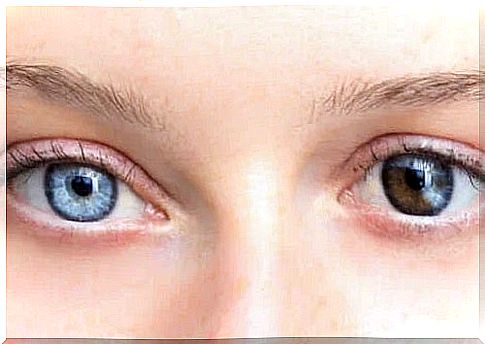Changing Eye Color: Truths And Myths

Eye color, as well as skin and hair color, is related to the production of melanin in the body. Some people experience a change in eye color during life for various reasons. In this article, we will reveal some of the myths that have emerged around this topic.
There are over 150 genes involved in the production, transport and storage of melanin. Melanin is the pigment that defines a person’s eye color.
People who have light blue-green eyes do not produce or store large amounts of melanin. People with darker eyes, from dark brown to black, produce and store a lot of melanin.
How is eye color determined?
According to an article published in the journal Missouri Medicine, the color of human eyes is determined by the density and size of melanocytes, which are the cellular structures that produce melanin. Melanocytes are located on the stroma of the iris and influence the color and shade of the eyes.
The above article also explains that the OCA2 gene on the 15th chromosome produces the protein responsible for creating and processing melanin. The more active this gene is, the more melanin it produces, resulting in darker eye colors. But there are other genes that can affect eye color, and many of them involve lighter colors, such as blue and green.
What does the iris do?
The iris is a flat, ring-shaped membrane made up of connective tissue and muscle fibers. It is located behind the cornea and surrounds the pupil. The iris is the part of the eye that has color and, together with the pupil, controls how much light enters the eye.
The muscle fibers in the iris help to enlarge and shrink the pupil to allow light to enter the eyes. When it works properly, this happens naturally in response to the amount of light in the environment.
According to the American Academy of Ophthalmology, it can sometimes seem that the eyes change color, but most often it is just an optical illusion. Changes in light cause the pupil to dilate, which can make the eyes appear to have a different color. It’s only temporary.
However, if you notice an obvious change in eye color in either one or both eyes, contact an optometrist immediately. Changing eye color is quite rare and can be a sign of a disease such as uveitis, hepatitis or aniridia caused by medication or eye trauma.

Popular beliefs about eye color change
True. In the first few months of life, melanocytes are just beginning to produce melanin in the body. Therefore, the color of a newborn’s eyes will change over time.
An article published by the American Academy of Pediatrics points out that melanocytes need about a year to produce all the melanin in the body. In other words, a baby’s gray or blue eyes may become darker in color in the first year of life.
Some children may be born with conditions that affect their pigmentation, such as albinism or heterochromia, in which case one eye may be different from the other or one eye may have multiple colors. Accidents, genetic factors or disease can cause this problem.
Fake. Green eyes are not the result of a genetic mutation, but rather the result of moderate melanin production and an average melanocyte density, as a study suggests .
Another study, published in the International Journal of Molecular Sciences, claims that the color of the eyes is not determined by the number of melanocytes. Instead, according to the study, the composition of melanin affects the color of the eyes. There are three types of melanin: eumelanin, pheomelanin and neuromelanin. Only pheomelanin influences eye color.
Fake. The mood does not change the color of the eyes or, at least, there are no studies to support this statement.
As mentioned earlier, light changes cause the pupil to dilate to adapt to a brighter or darker environment. When this happens, the iris is less visible, which may lead you to believe that the eyes have a different color. In addition, the eyes can even reflect the color of a nearby object, fueling this misperception.
This is true, but not recommended. In addition to using colored lenses, there are two operations that can change the appearance of the iris. One of these is the iris prosthetic implant, which was approved by the Food and Drug Administration (FDA) in 2018.
This type of surgery has emerged as a way to treat birth defects and repair the eye after an accident. However, it has quickly become a popular cosmetic procedure for changing eye color.
Most medical professionals do not recommend subjecting your eyes to this surgery, as the operation may compromise their proper functioning. Some of the risks of this surgery are increased intraocular pressure, intraocular inflammation, corneal edema, vision loss and glaucoma.
The second type of surgery is corneal keratopigmentation, often known as corneal tattooing. This procedure is recommended for patients with varying degrees of blindness, which causes opaque spots on the eyes.
The cornea tattoo helps to reduce the appearance of the affected eye and presents few risks, being a good option for cosmetic purposes. A clinical study evaluating the medium and long-term effects of the procedure found that it can cause sensitivity to light, discoloration of the eyes and keratitis.

Take care of your eyes
The eyes help us to look at the world around us and to carry out daily activities with ease. In fact, sight is considered to be the most important of the five senses. Although you may not like the color of your eyes, it is important to remember that these procedures can cause irreparable damage to the eyes and vision.
After the first year of life, the eyes usually do not change color. If you notice changes in eye color, go to an optometrist. It will help you understand why the changes have taken place and what you can do to keep your eyes healthy.









